Chemical Composition and In Vitro and In Silico Antileishmanial Evaluation of the Essential Oil from Croton linearis Jacq. Stems
Abstract
1. Introduction
2. Results
2.1. Extraction and Essential Oil Analysis
2.2. Antileishmanial Activity and Cytotoxicity
2.3. Molecular Docking
3. Discussion
4. Materials and Methods
4.1. Plant Material
4.2. Extraction and Analysis of the Essential Oil
4.3. Antileishmanial Assay
4.3.1. Parasites
4.3.2. Antipromastigote Assay
4.3.3. Antiamastigote Assay
4.3.4. Cytotoxic Assay
4.4. Molecular Docking Studies
5. Conclusions
Supplementary Materials
Author Contributions
Funding
Institutional Review Board Statement
Informed Consent Statement
Data Availability Statement
Acknowledgments
Conflicts of Interest
References
- McGwire, B.S.; Satoskar, A.R. Leishmaniasis: Clinical syndromes and treatment. QJM. Int. J. Med. 2014, 107, 7–14. [Google Scholar] [CrossRef]
- Alemayehu, B.; Alemayehu, M. Leishmaniasis: A review on parasite, vector and reservoir host. Health Sci. J. 2017, 11, 1–6. [Google Scholar] [CrossRef]
- Thakur, S.; Joshi, J.; Kaur, S. Leishmaniasis diagnosis: An update on the use of parasitological, immunological and molecular methods. J. Parasit. Dis. 2020, 44, 253–272. [Google Scholar] [CrossRef] [PubMed]
- WHO. Leishmaniasis. 2021. Available online: https://www.who.int/news-room/factsheets/detail/leishmaniasis. (accessed on 10 September 2021).
- Ghorbani, M.; Farhoudi, R. Leishmaniasis in humans: Drug or vaccine therapy? Drug Des. Devel. Ther. 2017, 12, 25. [Google Scholar] [CrossRef] [PubMed]
- Kumar, A.; Pandey, S.C.; Samant, M. Slow pace of antileishmanial drug development. Parasitol. Open 2018, 4, 1–11. [Google Scholar] [CrossRef]
- Soosaraei, M.; Fakhar, M.; Teshnizi, S.H.; Hezarjaribi, H.Z.; Banimostafavi, E.S. Medicinal plants with promising antileishmanial activity in Iran: A systematic review and meta-analysis. Ann. Med. Surg. 2017, 21, 63–80. [Google Scholar] [CrossRef] [PubMed]
- Da Silva, B.J.M.; Hage, A.A.P.; Silva, E.O.; Rodrigues, A.P.D. Medicinal plants from the Brazilian Amazonian region and their antileishmanial activity: A review. J. Integr. Med. 2018, 16, 211–222. [Google Scholar] [CrossRef]
- Nigatu, H.; Belay, A.; Ayalew, H.; Abebe, B.; Tadesse, A.; Tewabe, Y.; Degu, A. In vitro Antileishmanial Activity of Some Ethiopian Medicinal Plants. J. Exp. Pharm. 2021, 13, 15. [Google Scholar] [CrossRef] [PubMed]
- Rodrigues, K.A.F.; Amorim, L.V.; Dias, C.N.; Moraes, D.F.C.; Carneiro, S.M.P.; Carvalho, F.A.A. Syzygium cumini (L.) Skeels essential oil and its major constituent α-pinene exhibit anti-Leishmania activity through immunomodulation in vitro. J. Ethnopharmacol. 2015, 160, 32–40. [Google Scholar] [CrossRef] [PubMed]
- Silva, A.R.; Scher, R.; Santos, F.V.; Ferreira, S.R.; Cavalcanti, S.C.; Correa, C.B.; Dolabella, S.S. Leishmanicidal activity and structure-activity relationships of essential oil constituents. Molecules 2017, 22, 815. [Google Scholar] [CrossRef] [PubMed]
- Di Pasqua, R.; Betts, G.; Hoskins, N.; Edwards, M.; Ercolini, D.; Mauriello, G. Membrane toxicity of antimicrobial compounds from essential oils. J. Agric. Food Chem. 2007, 55, 4863–4870. [Google Scholar] [CrossRef] [PubMed]
- Bosquiroli, L.S.; Demarque, D.P.; Rizk, Y.S.; Cunha, M.C.; Marques, M.C.S.; Matos, M.D.F.C.; Arruda, C.C. In vitro anti-Leishmania infantum activity of essential oil from Piper angustifolium. Rev. Bras. Farmacog. 2015, 25, 124–128. [Google Scholar] [CrossRef]
- Moreira, R.R.D.; Santos, A.G.D.; Carvalho, F.A.; Perego, C.H.; Crevelin, E.J.; Crotti, A.E.M.; Nakamura, C.V. Antileishmanial activity of Melampodium divaricatum and Casearia sylvestris essential oils on Leishmania amazonensis. Rev. Inst. Med. Trop São Paulo 2019, 61, e33. [Google Scholar] [CrossRef]
- Salatino, A.; Salatino, M.; Negri, G. Traditional uses, chemistry and pharmacology of Croton species (Euphorbiaceae). J. Braz. Chem. Soc. 2007, 18, 11–33. [Google Scholar] [CrossRef]
- Marcelino, V.; Fechine, J.; Guedes, J.R.; Toscano, V.; Filgueiras, P.; Leitao, E.V.; Barbosa-Filho, J.M.; Sobral, M. Phytochemistry of the Genus Croton. Nat. Prod. Res. Rev. 2012, 1, 221–370. [Google Scholar]
- Nath, R.; Roy, S.; De, B.; Choudhury, M.D. Anticancer and antioxidant activity of Croton: A review. Int J. Pharm. Pharm. Sci. 2013, 5, 63–70. [Google Scholar]
- Junior, J.I.G.; Ferreira, M.R.A.; de Oliveira, A.M.; Soares, L.A.L. Croton sp.: A review about Popular Uses, Biological Activities and Chemical Composition. Res. Soc. Dev. 2022, 11, e57311225306. [Google Scholar] [CrossRef]
- Cavalcanti, J.M.; Leal-Cardoso, J.H.; Diniz, L.R.L.; Portella, V.G.; Costa, C.O.; Linard, C.F.B.M.; Alves, K.; Rocha, M.V.A.P.; Lima, C.C.; Cecatto, V.M.; et al. The essential oil of Croton zehntneri and trans-anethole improves cutaneous wound healing. J. Ethnopharmacol. 2012, 144, 240–247. [Google Scholar] [CrossRef] [PubMed]
- Rodrigues, I.A.; Azevedo, M.B.; Chaves, F.C.M.; Bizzo, H.R.; Corte-Real, S.; Alviano, D.S.; Alviano, C.S.; Rosa, M.S.S.; Vermelho, A.B. In vitro cytocidal effects of the essential oil from Croton cajucara (red sacaca) and its major constituent 7- hydroxycalamenene against Leishmania chagasi. BMC Complement. Altern. Med. 2013, 13, 249. [Google Scholar] [CrossRef] [PubMed]
- Araújo, F.M.; Dantas, M.C.; e Silva, L.S.; Aona, L.Y.; Tavares, I.F.; de Souza-Neta, L.C. Antibacterial activity and chemical composition of the essential oil of Croton heliotropiifolius Kunth from Amargosa, Bahia, Brazil. Indust. Crops Prod. 2017, 105, 203–206. [Google Scholar] [CrossRef]
- Souza, G.S.D.; Bonilla, O.H.; Lucena, E.M.P.D.; Barbosa, Y.P. Chemical composition and yield of essential oil from three Croton species. Cienc. Rural. 2017, 47, 1–8. [Google Scholar] [CrossRef]
- Roig, J.T. Plantas Medicinales, Aromáticas o Venenosas de Cuba, 1st ed.; Editorial Científico-Técnica: La Habana, Cuba, 1974; pp. 829–830. [Google Scholar]
- Sánchez, V.; Sandoval, D.; Herrera, P.; Oquendo, M. Alcaloides en especies cubanas del género Croton L. I. Estudio químico preliminar. Rev. Cubana Farm. 1982, 16, 39–44. [Google Scholar]
- Sánchez, V.; Sandoval, D. Alcaloides en especies cubanas del género Croton L. II. Contribución al estudio químico del C. stenophyllus Griseb. Rev. Cubana Farm. 1982, 16, 45–55. [Google Scholar]
- Payo, A.; Sandoval, D.; Vélez, H.; Oquendo, M. Alcaloides en la especie cubana Croton micradenus Urb. Rev. Cubana Farm. 2001, 35, 61–65. [Google Scholar]
- Garcia, J.; Tuenter, E.; Escalona-Arranz, J.C.; Llaurado, G.; Cos, P.; Pieters, L. Antimicrobial activity of leaf extracts and isolated constituents of Croton linearis. J. Ethnopharmacol. 2019, 236, 250–257. [Google Scholar] [CrossRef] [PubMed]
- Garcia, J.; Escalona-Arranz, J.C.; da Gama, D.; Monzote, L.; de la Vega, J.; de Macedo, M.B.; Cos, P. Antileishmanial potentialities of Croton linearis Jacq. leaves essential oil. Nat. Prod. Comm. 2018, 13, 629–634. [Google Scholar]
- Chatatikun, M.; Yamauchi, T.; Yamasaki, K.; Aiba, S.; Chiabchalard, A. Anti melanogenic effect of Croton roxburghii and Croton sublyratus leaves in α-MSH stimulated B16F10 cells. J. Tradit. Complement. Med. 2019, 9, 66–72. [Google Scholar] [CrossRef]
- Ximenes, R.M.; de Morais Nogueira, L.; Cassundé, N.M.R.; Jorge, R.J.B.; dos Santos, S.M.; Magalhães, L.P.M.; Silva, M.R.; de Barros Viana, G.S.; Araújo, R.M.; de Sena, K.X.; et al. Antinociceptive and wound healing activities of Croton adamantinus Müll. Arg. essential oil. J. Nat. Med. 2013, 67, 758–764. [Google Scholar] [CrossRef] [PubMed]
- Frum, Y.; Viljoen, A.M. In vitro 5-lipoxygenase and anti-oxidant activities of South African medicinal plants commonly used topically for skin diseases. Ski. Pharm. Physiol. 2006, 19, 329–335. [Google Scholar] [CrossRef] [PubMed]
- Ogungbe, I.V.; Erwin, W.R.; Setzer, W.N. Antileishmanial phytochemical phenolics: Molecular docking to potential protein targets. J. Mol. Graph. Model. 2014, 48, 105–117. [Google Scholar] [CrossRef] [PubMed]
- da Silva, E.R.; Maquiaveli, C.C.; Magalhães, P.P. The leishmanicidal flavonols quercetin and quercitrin target Leishmania (Leishmania) amazonensis arginase. Exp. Parasitol. 2012, 130, 183–188. [Google Scholar] [CrossRef] [PubMed]
- Fyfe, P.K.; Oza, S.L.; Fairlamb, A.H.; Hunter, W.N. Leishmania trypanothione synthetase-amidase structure reveals a basis for regulation of conflicting synthetic and hydrolytic activities. J. Biol. Chem. 2008, 283, 17672–17680. [Google Scholar] [CrossRef] [PubMed]
- Baiocco, P.; Colotti, G.; Franceschini, S.; Ilari, A. Molecular basis of antimony treatment in leishmaniasis. J. Med. Chem. 2009, 52, 2603–2612. [Google Scholar] [CrossRef]
- Hargrove, T.Y.; Wawrzak, Z.; Liu, J.; Nes, W.D.; Waterman, M.R.; Lepesheva, G.I. Substrate preferences and catalytic parameters determined by structural characteristics of sterol 14alpha-demethylase (CYP51) from Leishmania infantum. J. Biol. Chem. 2011, 286, 26838–26848. [Google Scholar] [CrossRef] [PubMed]
- da Camara, C.A.; de Moraes, M.M.; de Melo, J.P.; da Silva, M.M. Chemical composition and acaricidal activity of essential oils from Croton Rhamnifolioides Pax and Hoffm. In different regions of a caatinga biome in northeastern Brazil. J. Essent. Oil-Bear Plants 2017, 20, 1434–1449. [Google Scholar] [CrossRef]
- Peixoto, R.N.S.; Guilhon, G.M.S.P.; Das Graças, B.; Zoghbi, M.; Araújo, I.S.; Uetanabaro, A.P.T.; Santos, L.S.; Brasil, D.D.S.B. Volatiles, A Glutarimide Alkaloid and Antimicrobial Effects of Croton pullei (Euphorbiaceae). Molecules 2013, 18, 3195–3205. [Google Scholar] [CrossRef]
- Neves, I.D.A.; Camara, C.A.G. Volatile Constituents of Two Croton Species from Caatinga Biome of Pernambuco—Brasil. Rec. Nat. Prod. 2012, 6, 161–165. [Google Scholar]
- Silva, C.G.; Zago, H.B.; Júnior, H.J.; da Camara, C.A.; de Oliveira, J.V.; Barros, R.; Lucena, M.F. Composition and insecticidal activity of the essential oil of Croton grewioides Baill. against Mexican bean weevil (Zabrotes subfasciatus Boheman). J. Essent. Oil Res. 2008, 20, 179–182. [Google Scholar] [CrossRef]
- Miranda, F.M.; Braga do Nascimento Junior, B.; Aguiar, R.M.; Pereira, R.S.; De Oliveira Teixeira, A.; De Oliveira, D.M.; Froldi, G. Promising antifungal activity of Croton tricolor stem essential oil against Candida yeasts. J. Essent. Oil Res. 2019, 31, 223–227. [Google Scholar] [CrossRef]
- Setzer, W.N.; Stokes, S.L.; Bansal, A.; Haber, W.A.; Caffrey, C.R.; Hansell, E.; McKerrow, J.H. Chemical Composition and Cruzain Inhibitory Activity of Croton draco Bark Essential Oil from Monteverde, Costa Rica. Nat. Prod. Commun. 2007, 2, 685–689. [Google Scholar] [CrossRef]
- Neves, I.A.; da Camara, C.A. Acaricidal activity against Tetranychus urticae and essential oil composition of four Croton species from Caatinga biome in northeastern Brazil. Nat. Prod. Commun. 2011, 6, 893–899. [Google Scholar] [CrossRef] [PubMed]
- Radulovic, N.; Mananjarasoa, E.; Harinantenaina, L.; Yoshinori, A. Essential oil composition of four Croton species from Madagascar and their chemotaxonomy. Biochem. Syst. Ecol. 2006, 34, 648–653. [Google Scholar] [CrossRef]
- Amado, J.R.R.; Prada, A.L.; Diaz, J.G.; Souto, R.N.P.; Arranz, J.C.E.; de Souza, T.P. Development, larvicide activity, and toxicity in nontarget species of the Croton linearis Jacq essential oil nanoemulsion. Environ. Sci. Pollut. Res. 2020, 27, 9410–9423. [Google Scholar] [CrossRef] [PubMed]
- da Camara, C.A.; de Araujo, C.A.; de Moraes, M.M.; de Melo, J.P.; Lucena, M.F. Nuevas fuentes de acaricidas botánicos de especies de Croton con uso potencial en el manejo integrado de Tetranychus urticae. Bol. Lat. Caribe Plantas Med. Aromat. 2021, 20, 244–259. [Google Scholar] [CrossRef]
- Maury, G.; Méndez, D.; Hendrix, S.; Escalona, J.C.; Fung, Y.; Pacheco, A.O.; García, J.; Morris-Quevedo, H.J.; Ferrer, A.; Aleman, E.I.; et al. Antioxidants in Plants: A Valorization Potential Emphasizing the Need for the Conservation of Plant Biodiversity in Cuba. Antioxidants 2020, 9, 1048. [Google Scholar] [CrossRef] [PubMed]
- Mehalaine, S.; Chenchouni, H. Quantifying how climatic factors influence essential oil yield in wild-growing plants. Arab. J. Geosci. 2021, 14, 1257. [Google Scholar] [CrossRef]
- Morais, S.M.; Cossolosso, D.S.; Silva, A.A.; Moraes, M.O.D.; Teixeira, M.J.; Campello, C.C.; Vila-Nova, N.S. Essential oils from Croton species: Chemical composition, in vitro and in silico antileishmanial evaluation, antioxidant and cytotoxicity activities. J. Braz. Chem. Soc. 2019, 30, 2404–2412. [Google Scholar] [CrossRef]
- Tariku, Y.; Hymete, A.; Hailu, A.; Rohloff, J. Constituents, antileishmanial activity and toxicity profile of volatile oil from berries of Croton macrostachyus. Nat. Prod. Commun. 2010, 5, 975–980. [Google Scholar] [CrossRef] [PubMed]
- Monzote, L.; Scherbakov, A.M.; Scull, R.; Satyal, P.; Cos, P.; Shchekotikhin, A.E.; Gille, L.; Setzer, W.N. Essential Oil from Melaleuca leucadendra: Antimicrobial, Antikinetoplastid, Antiproliferative and Cytotoxic Assessment. Molecules 2020, 25, 5514. [Google Scholar] [CrossRef] [PubMed]
- Machado, M.; Dinis, A.M.; Santos-Rosa, M.; Alves, V.; Salgueiro, L.; Cavaleiro, C.; Sousa, M.C. Activity of Thymus capitellatus volatile extract, 1,8-cineole and borneol against Leishmania species. Vet. Parasitol. 2014, 200, 39–49. [Google Scholar] [CrossRef] [PubMed]
- Rosa, M.S.S.; Mendonça-Filho, R.R.; Bizzo, H.R.; Rodrigues, I.A.; Soares, R.M.A.; Souto-Padrón, T.; Alviano, C.S.; Lopes, A.H. Antileishmanial Activity of a Linalool-Rich Essential Oil from Croton cajucara. Antimicrob. Agents Chemother. 2003, 47, 1895–1901. [Google Scholar] [CrossRef] [PubMed]
- Garcia, M.C.F.; Soares, D.C.; Santana, R.C.; Saraiva, E.M.; Siani, A.C.; Ramos, M.F.S.; das Graças Miranda Danelli, M.; Souto-Padron, T.C.; Pinto-da-Silva, L.H. The in vitro antileishmanial activity of essential oil from Aloysia gratissima and guaiol, its major sesquiterpene against Leishmania amazonensis. Parasitology 2018, 145, 1219–1227. [Google Scholar] [CrossRef]
- Monzote, L.; García, M.; Pastor, J.; Gil, L.; Scull, R.; Maes, L.; Cos, P.; Gille, L. Essential oil from Chenopodium ambrosioides and main components: Activity against Leishmania, their mitochondria and other microorganisms. Exp. Parasitol. 2013, 136C, 20–26. [Google Scholar] [CrossRef]
- Pereira, P.S.; Oliveira, C.V.B.; Maia, A.J.; Tintino, S.R.; Oliveira-Tintino, C.D.d.M.; Vega-Gomez, M.C.; Rolón, M.; Coronel, C.; Duarte, A.E.; Barros, L.M.; et al. Cytotoxicity of Essential Oil Cordia verbenaceae against Leishmania brasiliensis and Trypanosoma cruzi. Molecules 2021, 26, 4485. [Google Scholar] [CrossRef] [PubMed]
- Vunda, S.L.L.; Sauter, I.P.; Cibulski, S.P.; Roehe, P.M.; Bordignon, S.A.L.; Rott, M.B.; Miriam, A.A.; von Poser, G.L. Chemical composition and amoebicidal activity of Croton pallidulus, Croton ericoides, and Croton isabelli (Euphorbiaceae) essential oils. Parasitol. Res. 2012, 111, 961–966. [Google Scholar] [CrossRef] [PubMed]
- Freiburghaus, F.; Kaminsky, R.; Nkunya, M.H.H.; Brun, R. Evaluation of African medicinal plants for their in vitro trypanocidal activity. J. Ethnopharmacol. 1996, 55, 1. [Google Scholar] [CrossRef] [PubMed]
- Shangguan, Z. A Review of Target Identification Strategies for Drug Discovery: From Database to Machine-Based Methods. J. Phys. Conf. Ser. 2021, 1893, 012013. [Google Scholar] [CrossRef]
- Hosen, M.I.; Tanmoy, A.M.; Mahbuba, D.A.; Salma, U.; Nazim, M.; Islam, M.T.; Akhteruzzaman, S. Application of a subtractive genomics approach for in silico identification and characterization of novel drug targets in Mycobacterium tuberculosis F11. Interdiscip. Sci. Comput. Life Sci. 2014, 6, 48–56. [Google Scholar] [CrossRef] [PubMed]
- Sharma, M.; Shaikh, N.; Yadav, S.; Singh, S.; Garg, P. A systematic reconstruction and constraintbased analysis of Leishmania donovani metabolic network: Identification of potential antileishmanial drug targets. Mol. BioSyst. 2017, 13, 955–969. [Google Scholar] [CrossRef] [PubMed]
- Jain, V.; Jain, K. Molecular targets and pathways for the treatment of visceral leishmaniasis. Drug Discov. Today 2018, 23, 161–170. [Google Scholar] [CrossRef] [PubMed]
- Reigada, C.; Sayé, M.; Vera, E.V.; Balcazar, D.; Fraccaroli, L.; Carrillo, C.; Miranda, M.R.; Pereira, C.A. Trypanosoma cruzi Polyamine Transporter: Its Role on Parasite Growth and Survival Under Stress Conditions. J. Membr. Biol. 2016, 249, 475–481. [Google Scholar] [CrossRef] [PubMed]
- Garcia, A.R.; Oliveira, D.M.P.; Amaral, A.C.F.; Jesus, J.B.; Sodero, A.C.R.; Souza, A.M.T.; Supuran, C.T.; Vermelho, A.B.; Rodrigues, I.A.; Pinheiro, A.S. Leishmania infantum arginase: Biochemical characterization and inhibition by naturally occurring phenolic substances. J. Enzym. Inhib. Med. Chem. 2019, 34, 1100–1109. [Google Scholar] [CrossRef] [PubMed]
- Camargo, P.G.; Bortoleti, B.T.D.S.; Fabris, M.; Gonçalves, M.D.; Tomiotto-Pellissier, F.; Costa, I.N.; Macedo Jr, F. Thiohydantoins as anti-leishmanial agents: In vitro biological evaluation and multi-target investigation by molecular docking studies. J. Biomol. Struct. Dyn. 2022, 40, 3213–3222. [Google Scholar] [CrossRef] [PubMed]
- D’Antonio, E.L.; Ullman, B.; Roberts, S.C.; Dixit, U.G.; Wilson, M.E.; Hai, Y.; Christianson, D.W. Crystal structure of arginase from Leishmania mexicana and implications for the inhibition of polyamine biosynthesis in parasitic infections. Arch. Biochem. Biophys. 2013, 535, 163–176. [Google Scholar] [CrossRef] [PubMed]
- Ilari, A.; Fiorillo, A.; Genovese, I.; SannerColotti, G. Polyamine-trypanothione pathway: An update. Future Med. Chem. 2017, 9, 61–77. [Google Scholar] [CrossRef] [PubMed]
- Feitosa, A.O.; Ferreira, F.J.; Brigido, H.P.; Bastos, M.L.; Carvalho, J.M.; Carneiro, A.S.; Marinho, A.M. Study on Experimental Leishmanicidal Activity and in silico of Cytochalasin B. J. Braz. Chem. Soc. 2019, 30, 592–596. [Google Scholar] [CrossRef]
- Lepesheva, G.I.; Friggeri, L.; Waterman, M.R. CYP51 as drug targets for fungi and protozoan parasites: Past, present and future. Parasitology 2018, 145, 1820–1836. [Google Scholar] [CrossRef]
- De Vita, D.; Moraca, F.; Zamperini, C.; Pandolfi, F.; Di Santo, R.; Matheeussen, A.; Scipione, L. In vitro screening of 2-(1H-imidazol-1-yl)-1-phenylethanol derivatives as antiprotozoal agents and docking studies on Trypanosoma cruzi CYP51. Eur. J. Med. Chem. 2016, 113, 28–33. [Google Scholar] [CrossRef] [PubMed]
- Sheng, C.; Miao, Z.; Ji, H.; Yao, J.; Wang, W.; Che, X.; Dong, G.; Lü, J.; Guo, W.; Zhang, W. Three-dimensional model of lanosterol 14 alpha-demethylase from Cryptococcus neoformans: Active-site characterization and insights into azole binding. Antimicrob. Agents Chemother. 2009, 53, 3487–3495. [Google Scholar] [CrossRef] [PubMed]
- Sladowski, D.; Steer, S.J.; Clothier, R.H.; Balls, M. An improve MTT assay. J. Immunol. Methods 1993, 157, 203–207. [Google Scholar] [CrossRef] [PubMed]
- Morris, G.M.; Huey, R.; Lindstrom, W.; Sanner, M.F.; Belew, R.K.; Goodsell, D.S.; Olson, A.J. AutoDock4 and AutoDockTools4: Automated docking with selective receptor flexibility. J. Comput. Chem. 2009, 30, 2785–2791. [Google Scholar] [CrossRef] [PubMed]
- Evans, D.A. History of the Harvard ChemDraw Project. Angew. Chem. Int. Ed. 2014, 53, 11140–11145. [Google Scholar] [CrossRef] [PubMed]
- Ogungbe, I.V.; Setzer, W.N. The potential of secondary metabolites from plants as drugs or leads against protozoan neglected diseases—Part III: In-silico molecular docking investigations. Molecules 2016, 21, 1389. [Google Scholar] [CrossRef] [PubMed]
- BIOVIA Discovery Studio. Discovery Studio Visualizer, 20.1.0.19295; Accelrys Software Inc.: San Diego, CA, USA, 2019.
- Arba, M.; Ihsan, S.; Ramadhan, L.O.A.N.; Tjahjono, D.H. In silico study of porphyrin-anthraquinone hybrids as CDK2 inhibitor. Comput. Biol. Chem. 2017, 67, 9–14. [Google Scholar] [CrossRef]
- Nguewa, P.A.; Fuertes, M.A.; Cepeda, V.; Iborra, S.; Carrión, J.; Valladares, B.; Pérez, J.M. Pentamidine is an antiparasitic and apoptotic drug that selectively modifies ubiquitin. Chem. Biodiver. 2005, 2, 1387–1400. [Google Scholar] [CrossRef] [PubMed]
- Dorlo, T.P.; Balasegaram, M.; Beijnen, J.H.; de Vries, P.J. Miltefosine: A review of its pharmacology and therapeutic efficacy in the treatment of leishmaniasis. J. Antimicrob. Chemother. 2012, 67, 2576–2597. [Google Scholar] [CrossRef]
- Setzer, M.S.; Byler, K.G.; Ogungbe, I.V.; Setzer, W.N. Natural products as new treatment options for trichomoniasis: A molecular docking investigation. Sci. Pharm. 2017, 85, 5. [Google Scholar] [CrossRef]

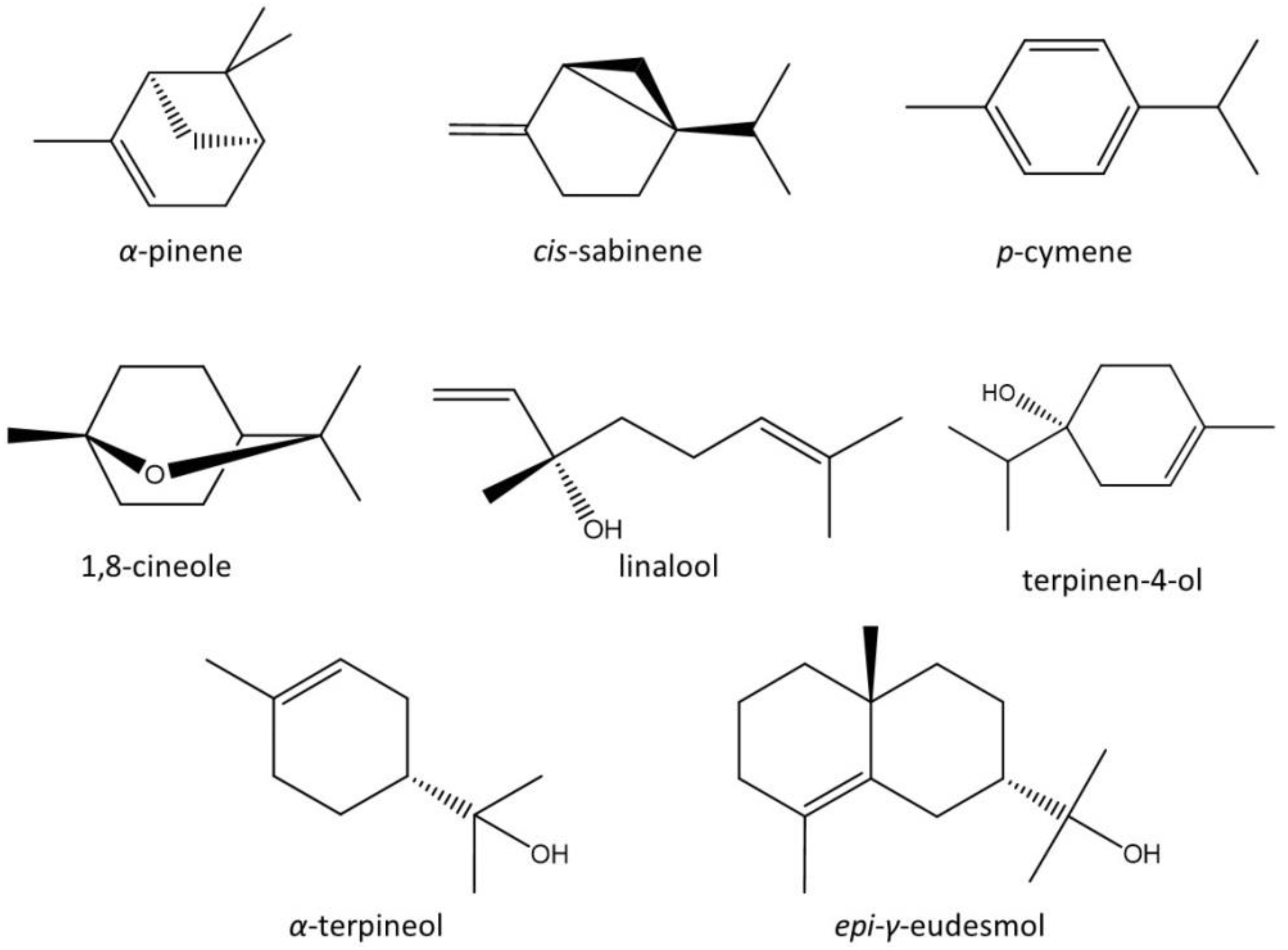
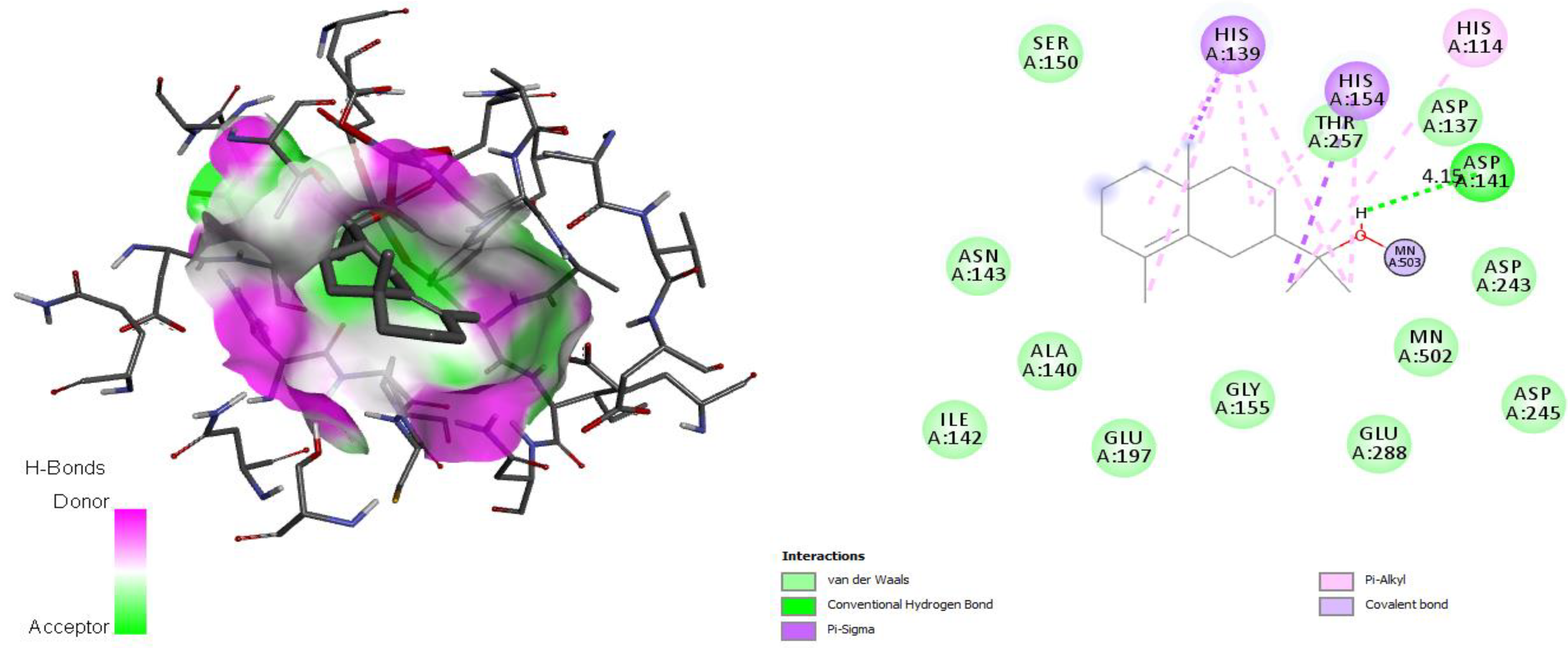
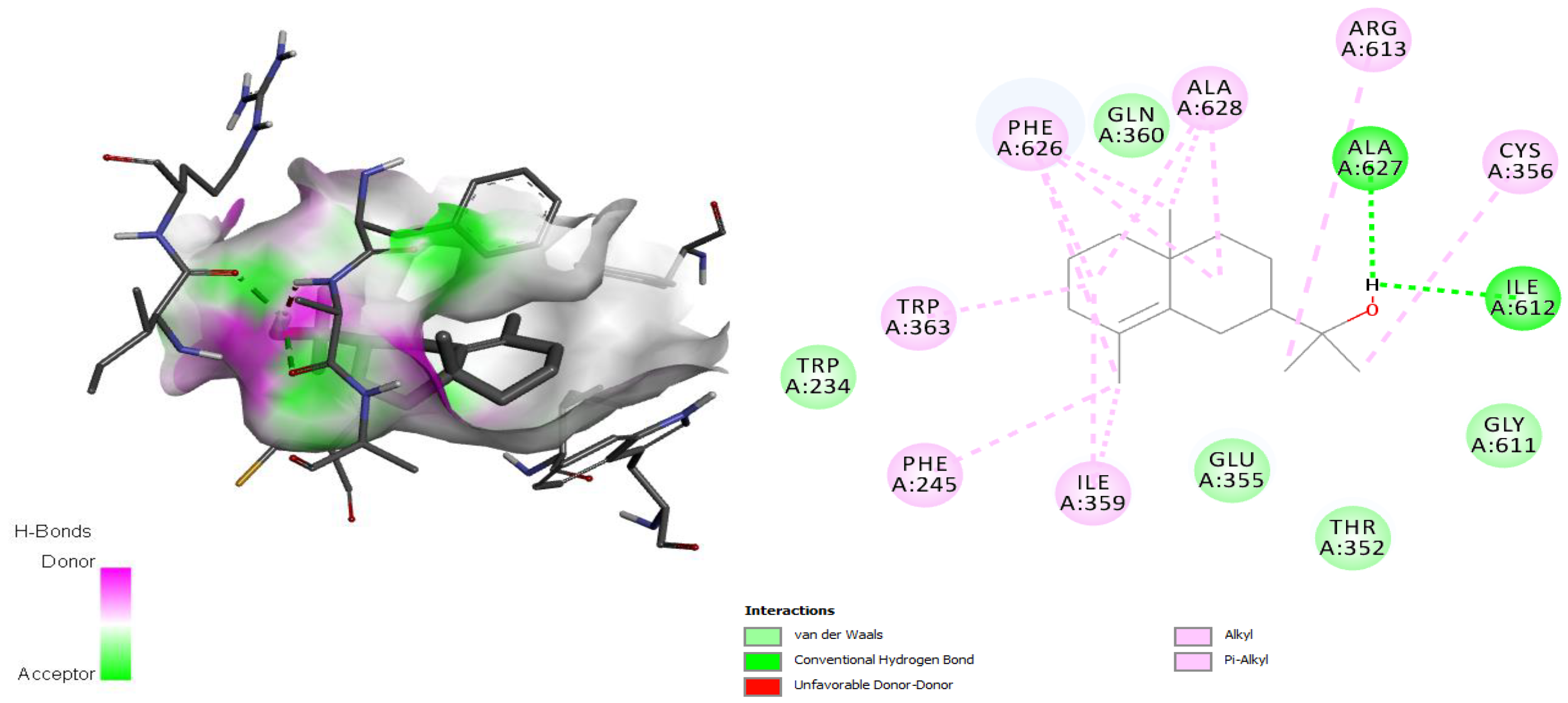
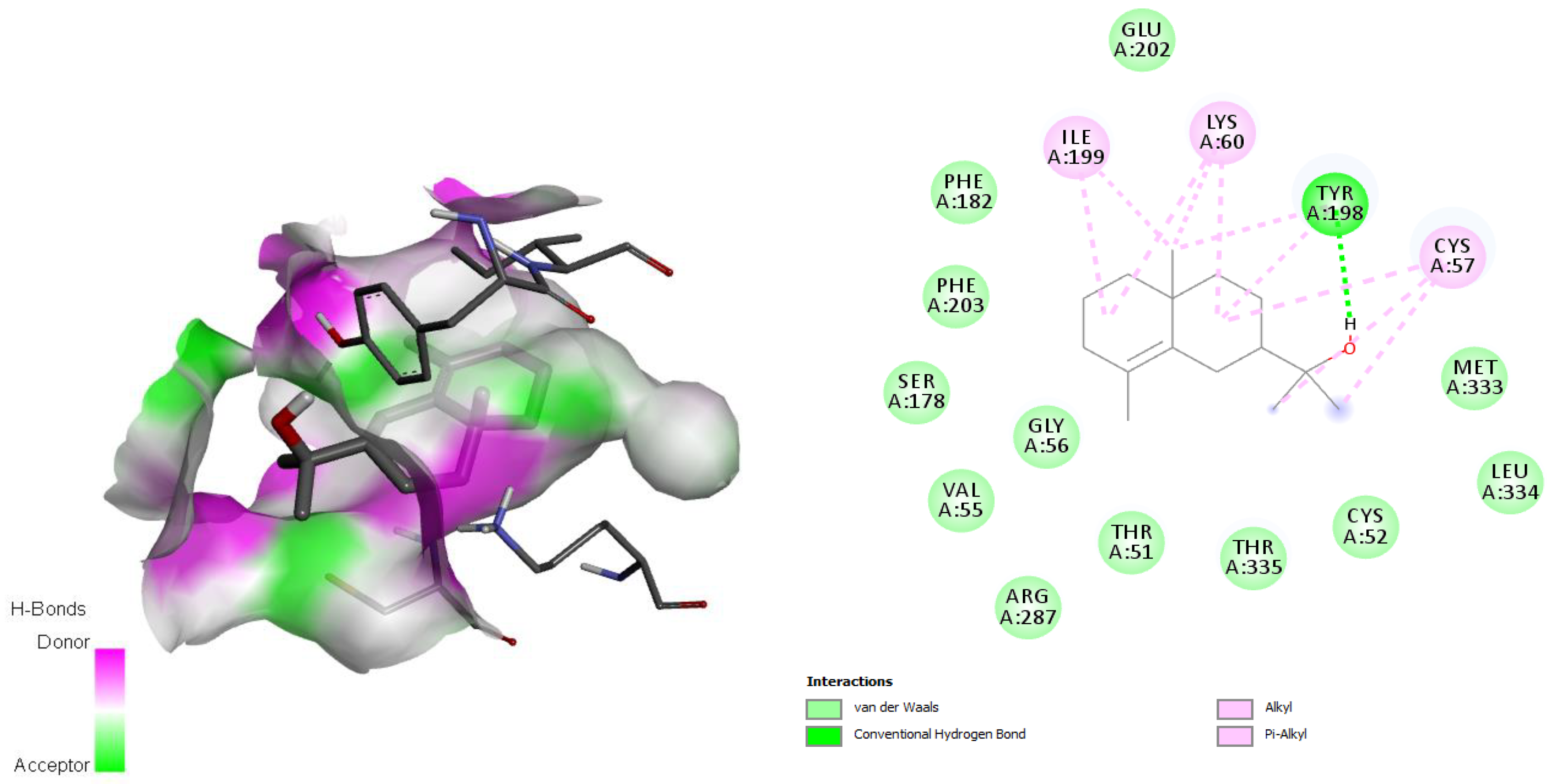
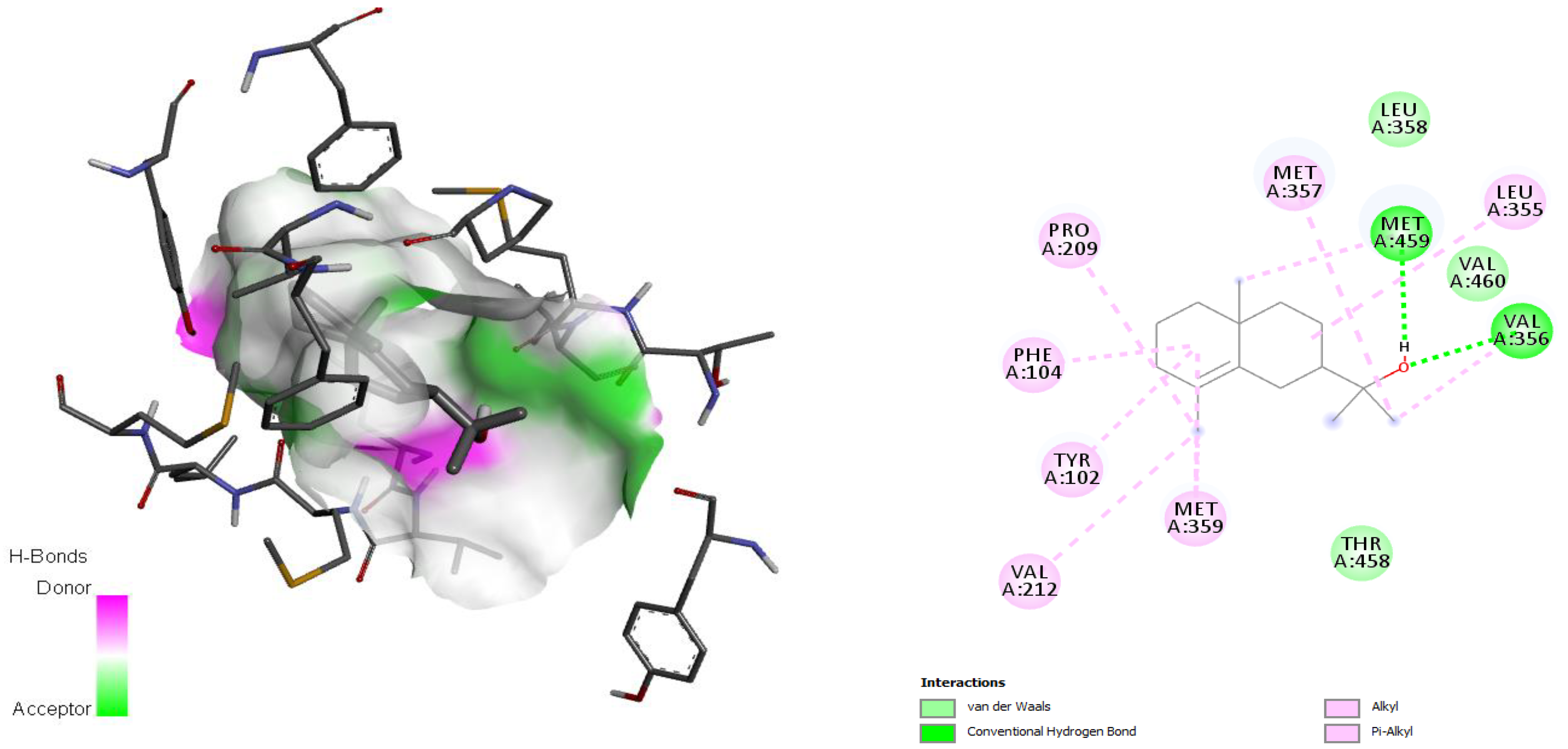
| Rt a (min) | Compounds | % RA b | RIexp c | RIlit d | Rt (min) | Compounds | % RA | RIexp | RIlit |
|---|---|---|---|---|---|---|---|---|---|
| 5.73 | α-thujene | 1.28 | 926 | 926 | 25.86 | not identified | 0.32 | 1427 | - |
| 5.94 | α-pinene | 11.05 | 934 | 938 | 27.18 | α-humulene | 0.18 | 1458 | 1454 |
| 6.37 | α-fenchene | 0.45 | 949 | 943 | 28.30 | α-amorphene | 0.38 | 1484 | 1484 |
| 7.07 | cis-sabinene | 8.06 | 974 | 976 | 28.75 | β-selinene | 0.47 | 1495 | 1497 |
| 7.19 | β-pinene | 1.18 | 978 | 979 | 28.93 | α-selinene | 0.23 | 1499 | 1499 |
| 7.55 | β-myrcene | 1.30 | 991 | 990 | 29.41 | γ-cadinene | 0.19 | 1511 | 1512 |
| 8.05 | α-phellandrene | 1.20 | 1006 | 1002 | 29.80 | cubebol | 0.14 | 1521 | 1521 |
| 8.46 | α-terpinene | 0.85 | 1017 | 1017 | 30.10 | zonarene | 0.61 | 1528 | 1528 |
| 8.75 | p-cymene | 5.72 | 1025 | 1026 | 30.70 | selina-4(15),7(11)-diene | 0.57 | 1542 | 1540 |
| 8.90 | limonene | 1.31 | 1029 | 1031 | 31.19 | germacrene B | 0.27 | 1555 | 1555 |
| 9.00 | 1,8-cineole (eucalyptol) | 27.83 | 1032 | 1033 | 31.68 | dihydroisocaryophyllene epoxide | 0.89 | 1566 | 1565 |
| 9.17 | Z-β-ocimene | 1.04 | 1036 | 1041 | 32.08 | germacrene D-4-ol | 0.17 | 1576 | 1576 |
| 9.56 | E-β-ocimene | 0.19 | 1046 | 1044 | 32.28 | spathulenol | 0.16 | 1581 | 1578 |
| 10.01 | γ-terpinene | 1.00 | 1058 | 1059 | 32.58 | caryophyllene oxide | 0.88 | 1589 | 1589 |
| 10.36 | cis-sabinene hydrate | 0.21 | 1068 | 1066 | 33.25 | guaiol | 1.93 | 1605 | 1605 |
| 10.53 | cis-linalool oxide | 0.13 | 1072 | 1074 | 33.41 | copaborneol | 0.14 | 1609 | 1593 |
| 11.17 | terpinolene | 0.29 | 1089 | 1088 | 33.64 | humulene epoxide II | 0.14 | 1615 | 1614 |
| 11.63 | linalool | 3.91 | 1101 | 1098 | 33.88 | (2Z)-2,6-dimethyl-2,7-octadiene-1,6-diol | 0.54 | 1621 | 1617 |
| 12.57 | cis-p-menth-2-en-1-ol | 0.11 | 1123 | 1121 | 34.04 | epi-γ-eudesmol | 4.15 | 1626 | 1627 |
| 13.35 | cis-verbenol | 0.14 | 1141 | 1142 | 34.38 | γ-eudesmol | 0.35 | 1634 | 1635 |
| 14.56 | δ-terpineol | 0,33 | 1170 | 1173 | 34.60 | 3-methyl-5-(1,4,4-trimethylcyclohex-2-enyl)pentan-1-ol | 2.09 | 1640 | 1637 |
| 15.00 | terpinen-4-ol | 2.55 | 1180 | 1177 | 34.80 | hinesol | 2.98 | 1645 | 1638 |
| 15.61 | α-terpineol | 4.35 | 1194 | 1189 | 34.88 | α-muurolol | 1.49 | 1649 | 1649 |
| 17.50 | thymol methyl ether | 0.78 | 1237 | 1234 | 35.16 | valerianol | 1.15 | 1654 | 1655 |
| 17.91 | 2-isopropyl-1-methoxy-4-methylbenzene | 0.18 | 1246 | 1244 | 35.42 | cadin-4-en-10-ol | 0.88 | 1660 | 1663 |
| 19.79 | isobornyl acetate | 0.45 | 1289 | 1286 | 36.10 | 9E,12Z-tetradecadien-1-ol | 0.23 | 1677 | 1676 |
| 24.50 | β-elemene | 0.66 | 1395 | 1394 | 36.85 | geranyl tiglate | 0.79 | 1697 | 1700 |
| 25.25 | longifolene | 0.28 | 1412 | 1412 | 37.04 | E,E-farnesal | 0.19 | 1729 | 1730 |
| 25.71 | E-caryophyllene | 0.66 | 1423 | 1427 | |||||
| Monoterpene hydrocarbons | 14 (34.84%) | ||||||||
| Oxygenated monoterpenes | 12 (41.05%) | ||||||||
| Sesquiterpene hydrocarbons | 12 (4.82%) | ||||||||
| Oxygenated sesquiterpenes | 19 (19.29%) | ||||||||
| Sample | Cytotoxicity | Anti-Leishmania Activity | |||
|---|---|---|---|---|---|
| Macrophages CC50% a ± SD b (µg/mL) | Promastigotes IC50% c ± SD (µg/mL) | Selectivity Index d | Amastigotes IC50% ± SD (µg/mL) | Selectivity Index e | |
| CLS-EO | 49.0 ± 5.0 | 21.4 ± 0.1 | 2 | 18.9 ± 0.3 | 3 |
| Pentamidine® f | 11.7 ± 1.7 | 0.4 ± 0.1 | 29 | 1.3 ± 0.1 | 9 |
| Compounds | MW (g/mol) | Leishmania Enzyme Targets | |||||||
|---|---|---|---|---|---|---|---|---|---|
| Cyp51 | TryR | TryS | ArgI | ||||||
| ΔGdock | DSnorm | ΔGdock | DSnorm | ΔGdock | DSnorm | ΔGdock | DSnorm | ||
| 1,8-cineole | 154.253 | −5.84 | −6.22 | −5.13 | −5.46 | −5.57 | −5.93 | −4.47 | −4.76 |
| α-pinene | 136.238 | −5.63 | −6.25 | −4.89 | −5.43 | −5.85 | −6.49 | −4.1 | −4.55 |
| α-terpineol | 154.253 | −5.88 | −6.26 | −5.72 | −6.09 | −7.09 | −7.55 | −6.54 | −6.96 |
| cis-sabinene | 136.238 | −5.27 | −5.85 | −4.93 | −5.47 | −5.78 | −6.42 | −3.83 | −4.25 |
| epi-γ-eudesmol | 222.372 | −7.79 | −7.34 | −7.20 | −6.79 | −7.87 | −7.42 | −7.87 | −7.42 |
| linalool | 154.253 | −5.49 | −5.85 | −4.84 | −5.15 | −6.44 | −6.86 | −6.28 | −6.69 |
| p-cymene | 134.222 | −5.28 | −5.89 | −4.88 | −5.44 | −6.18 | −6.89 | −4.01 | −4.47 |
| terpinen-4-ol | 154.253 | −5.73 | −6.10 | −5.48 | −5.84 | −6.35 | −6.76 | −5.4 | −5.75 |
| Miltefosine a | 407.576 | −8.96 | −6.90 | −4.72 | −3.64 | −5.47 | −4.21 | −2.99 | −2.30 |
| Pentamidine a | 340.427 | −9.22 | −7.54 | −8.57 | −7.01 | −8.71 | −7.12 | −6.00 | −4.91 |
| Protein | Species | PDB ID | Resolution | Grid Box Center Coordinates | Grid Box Size | ||
|---|---|---|---|---|---|---|---|
| x | y | z | |||||
| Cyp51 | L. infantum | 3L4D | 2.75 | 31.917 | −28.96 | −1.658 | 50 × 50 × 50 |
| TryR | L. infantum | 2JK6 | 2.95 | 30.449 | 47.483 | −4.312 | |
| TryS | L. major | 2VOB | 2.3 | −5.339 | −21.67 | 8.498 | |
| ArgI | L. mexicana | 4ITY | 1.8 | 15.141 | −15.125 | −5.4 | |
Publisher’s Note: MDPI stays neutral with regard to jurisdictional claims in published maps and institutional affiliations. |
© 2022 by the authors. Licensee MDPI, Basel, Switzerland. This article is an open access article distributed under the terms and conditions of the Creative Commons Attribution (CC BY) license (https://creativecommons.org/licenses/by/4.0/).
Share and Cite
García-Díaz, J.; Escalona-Arranz, J.C.; Ochoa-Pacheco, A.; Santos, S.G.D.; González-Fernández, R.; Rojas-Vargas, J.A.; Monzote, L.; Setzer, W.N. Chemical Composition and In Vitro and In Silico Antileishmanial Evaluation of the Essential Oil from Croton linearis Jacq. Stems. Antibiotics 2022, 11, 1712. https://doi.org/10.3390/antibiotics11121712
García-Díaz J, Escalona-Arranz JC, Ochoa-Pacheco A, Santos SGD, González-Fernández R, Rojas-Vargas JA, Monzote L, Setzer WN. Chemical Composition and In Vitro and In Silico Antileishmanial Evaluation of the Essential Oil from Croton linearis Jacq. Stems. Antibiotics. 2022; 11(12):1712. https://doi.org/10.3390/antibiotics11121712
Chicago/Turabian StyleGarcía-Díaz, Jesús, Julio César Escalona-Arranz, Ania Ochoa-Pacheco, Sócrates Golzio Dos Santos, Rosalia González-Fernández, Julio Alberto Rojas-Vargas, Lianet Monzote, and William N. Setzer. 2022. "Chemical Composition and In Vitro and In Silico Antileishmanial Evaluation of the Essential Oil from Croton linearis Jacq. Stems" Antibiotics 11, no. 12: 1712. https://doi.org/10.3390/antibiotics11121712
APA StyleGarcía-Díaz, J., Escalona-Arranz, J. C., Ochoa-Pacheco, A., Santos, S. G. D., González-Fernández, R., Rojas-Vargas, J. A., Monzote, L., & Setzer, W. N. (2022). Chemical Composition and In Vitro and In Silico Antileishmanial Evaluation of the Essential Oil from Croton linearis Jacq. Stems. Antibiotics, 11(12), 1712. https://doi.org/10.3390/antibiotics11121712










